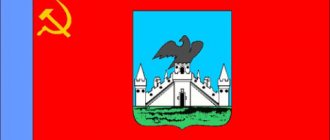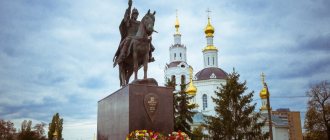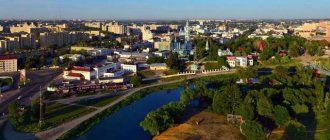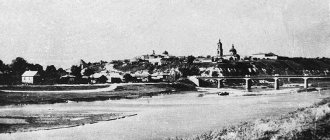The city of Orel is located within the Central Russian Upland, on the banks of the Oka and its tributary Orlik, 380 km southeast of Moscow.
On August 16, 1781, the provincial city of Orel received its first Imperially approved coat of arms. It is a blue heraldic shield of the French form. In its central part there is a white three-towered city standing on a green field. On the central tower, with a gate, sits a black single-headed eagle with a golden crown on its head.
Founding of the city of Orel
The history of the city of Orel begins in 1566, when the city was founded by Tsar Ivan IV the Terrible as a fortress to protect the southern borders of the Moscow state. It got its name from its location at the confluence of the Orel River into the Oka.
Although, as archaeological research has shown, a settlement existed on this site for a very long time - since the 12th century. Most likely, it was a fortress of the Vyatichi Slavs within the Grand Duchy of Chernigov. However, there is no written evidence of the existence of Orel before the Mongols, nor any indication of when and under what circumstances the ancient settlement was abandoned.
Thus, city history is traditionally measured from 1566, from Ivan Vasilyevich. However, a number of modern studies specifically dispute Ivan Vasilyevich’s participation in the founding of the city (the lands on which Orel stands, under Grozny, were not part of the sovereign’s oprichnina, but the zemshchina, and accordingly, the tsar could not build anything on it).
All this, however, did not stop the Oryol residents from erecting a monument to Ivan IV by sculptor A. Sledkov not far from the spit in 2016. A brave monument. Few Russian cities can boast of this. Ivan the Terrible is a controversial figure in Russian history, to put it mildly.
Chronicle of the city
By decrees of Catherine II of February 28 (March 11) and September 5 (16), 1778, the Oryol province and the Oryol governorship were established. Orel became the administrative center of the province, and until 1796 - also of the governorship. At this time, the city's population was about 7.7 thousand people.
The industry of the city began with the appearance at the turn of the 17th-18th centuries. small handicraft enterprises for processing agricultural raw materials. In 1698, one of the first linen (sail) factories in Russia was opened near the city. In 1722, a hemp spinning workshop arose, uniting 29 artisans. In 1759, a spinning and cloth factory was established, and in 1768, a sawing factory.
In the first half. XIX century Oryol retained its significance as a major shopping center. In 1844, 259 ships supplied cargo from the Oka pier to the northern regions of the country.
In 1834, the first metalworking enterprise of the Moscow master A. Vorobyov was opened in the city, where bells for churches were cast. The number of enterprises associated with the processing of livestock products and plant raw materials grew.
By the middle of the 19th century, Orel's population reached 32,504 people.
In 1868, railways were built through Orel. With their appearance, the importance of the waterway decreased. An average of 5.5 million pounds of grain cargo, 437 thousand pounds of hemp, 500 thousand pounds of hemp oil, and 70 thousand pounds of meat were exported annually by rail.
The first educational institutions in Orel were theological schools. In 1725-1775 A theological school operated in the city to prepare children of clergy for entry into the Kolomna Seminary. In 1779-1798. There was a theological school at the Assumption Monastery. In 1780, the first civil public school for children of the lower classes was opened, which in 1786 was included in the new educational institution - the Main People's 4-grade School. In 1808, a men's gymnasium was opened on its basis, which existed until 1918.
In 1812 in Orel, under the provincial rule of the merchant I.Ya. Sytin created the first printing house.
September 26 (October 8), 1815 by Oryol landowner Count S.M. Kamensky opened a serf theater, which laid the foundation for professional theater in the province.
Since 1820, Oryol became the residence of the bishops of the Oryol diocese, opened in 1788. The bishop's house, transferred from Sevsk, was located on the territory of the Assumption Monastery. The transfer of the bishop's see to Orel contributed to the development of spiritual education. Since 1817, the first, and since 1833, the second theological schools operated in Orel (closed in 1918). And on September 20 (October 2), 1817, a theological seminary transferred from Sevsk was opened.
From 1830 to 1850 Several significant events occurred in the history of Orel. In 1838, the first local newspaper, the Oryol Provincial Gazette, began publication - an official government organ. In the same year, on the initiative of private individuals, the first public library was opened, which existed with interruptions until 1866.
An event of all-Russian significance was the opening on December 6 (18), 1843 of the Orlovsky-Bakhtin Cadet Corps - one of the best institutions in the country, built with donations from the Bryansk landowner M.P. Bakhtin.
In 1859, telegraph communication was first established with Orel. A telegraph line connected the city with St. Petersburg and Moscow. A telegraph station was put into operation.
Reforms 1860-70 made significant changes in all areas of city life. Banking has developed. In 1863, the first water supply system appeared in Orel. In 1876, construction began on the first permanent high-water bridges according to the design of engineers Verkhovtsev and Lebedinsky. On February 17 (March 1), 1879, the Mariinsky (from 1919 - Red) bridge across the Oka River was opened, and on February 19 (March 2), 1880 - the Aleksandrovsky (from 1919 - Leninsky) bridge across the river. Orlik. Both bridges were blown up in August 1943 during the retreat of German troops from Orel.
In 1881, a telephone line was installed for the first time in Orel, connecting the police department with the police chief’s apartment. In 1892, a telephone exchange for 35 subscribers was put into operation. By January 1, 1897, there were 86 telephone points in Orel. In 1911, a long-distance telephone line connected Opel with Moscow and other cities. In 1913, the city's telephone network numbered 400 subscribers.
In 1895, the power plant began operating; for the first time, electric lighting appeared on the streets and in some houses of the city. In 1901, 50 electric arc lamps were lit in Orel. By 1910, their number reached 66. However, kerosene lanterns still predominated, of which there were 850.
Oryol became the second city (after Kyiv) where tram service was opened on November 5 (17), 1898.
In 1905, a permanent cinema (electric theater) was established in Orel, which Orel residents first became acquainted with in 1896. By 1917, three cinemas were operating in Orel.
Since the 1860s, the city network of educational institutions continued to expand. By 1917, the city had 3 men's and 4 women's gymnasiums, a Bakhtin cadet corps, the Alexandria Institute of Noble Maidens, a theological seminary, a women's teacher's seminary, a women's private gymnasium, 2 real schools (1 private), a men's commercial school, 2 theological schools, Diocesan girls' school, paramedic and midwifery school. In addition, the evacuated Vilna 2nd men's and Lovichi women's gymnasiums were located in Orel.
Medical care was provided by the provincial zemstvo hospital, founded as a provincial hospital in 1782 (the regional hospital named after MOPR was founded from it). In addition, in Orel by 1917 there were a hospital of the district zemstvo, a hospital and maternity hospital at the Oryol Medical Society, a hospital of the Community of Sisters of Charity of the Red Cross, a private hydropathic clinic and an eye clinic. The city maintained a noble boarding house-shelter, a House of Diligence (since 1891), 4 shelters, a House of Charity, 2 almshouses and 2 shelters for the elderly. During the First World War, 33 military hospitals were organized in the city.
The spiritual life of the Oryol residents was closely connected with the church. On the eve of the revolution, there were 33 churches in the city, including monasteries and cemeteries. Many of them were destroyed during the years of Soviet power. However, these days, the monasteries and temples of Orel are being revived, and the walls of new sanctuaries are being erected. Today in Orel there are two monasteries, twelve churches, including a house church in the diocesan administration building, and five chapels.
In 1920, the population of the city with settlements was 63.8 thousand people. There were 50 schools. There were 10 kindergartens, 13 orphanages, 11 clubs, 2 folk houses, 10 music, 4 theater and 2 art studios, 7 independent and 23 auxiliary libraries.
On November 20, 1921, provincial hospital No. 5 was organized in the city, which the following year was named after N.A. Semashko (now the city emergency hospital named after N.A. Semashko).
In 1924, on April 22, the House of Education was opened, and on August 31, the Central House of Pioneers. In the same year, on May 24, the first performance took place in the circus building built in the city park, which operated in Orel until 1941. On October 15, 1925, a theater school was opened to prepare for admission to the Moscow Central College of Theater Arts. In September 1926, the music, art, and theater schools were merged into the united School of Arts.
In 1925, the Red Banner Ivanovo-Voznesensk School named after. M.V. Frunze. In 1930, the country's first tank school was opened at its base, which in 1937 was transformed into the Oryol Tank School named after. M.V. Frunze. The school went down in the history of the Soviet Armed Forces as a forge of first-class tank officers, over 80 of whom became Heroes of the Soviet Union.
In 1927, the city introduced universal compulsory primary education. In 1932, universal education was implemented on the basis of a seven-year plan. Oryol was one of the first in the country to become a city of complete literacy.
By 1941, 110.6 thousand people lived in Orel.
On October 3, 1941, Orel was captured by the 4th Panzer Division of the 2nd Panzer Group of General G. Guderian, which was part of the German Army Group Center.
A camp for prisoners of war and civilians was organized in the city, in which about 5 thousand people were killed. Over 20 thousand women were deported from Orel to Germany.
On August 5, 1943, as a result of the Oryol offensive operation "Kutuzov" during the Battle of Kursk, Oryol was liberated. In honor of the liberation of Orel and Belgorod, the first artillery salute in the history of the Great Patriotic War was given in Moscow.
The occupation caused great damage to the city. All enterprises were destroyed, bridges and power plants were blown up, water supply and trams were disabled. More than 2,200 residential buildings, 33 educational institutions, 19 medical institutions, a station and railway junction, a telephone exchange, a radio center, cultural institutions, shops, kindergartens, and hotels were destroyed. Orel was one of the 15 largest and oldest Russian cities that suffered the most during the war, the priority restoration of which was determined by the decree of the Council of People's Commissars of the USSR on November 1, 1945. And Orel was reborn from the ashes and ruins as a modern beautiful city.
The eagle is closely associated with the names of prominent people. Writers I.S. were born here. Turgenev, L.N. Andreev, B.K. Zaitsev, historian T.N. Granovsky, polar explorer V.A. Rusanov. Writers N.S. lived, studied and worked in Orel. Leskov, I.A. Bunin, F.D. Kryukov, Marko Vovchok, P.L. Proskurin, N.N. Bakhtin, composers M.I. Glinka, A.S. Glukhovtsev, historians M.K. Lemke, V.S. Sergeev, L.M. Savelov, state and public figures M.A. Stakhovich, P.A. Stolypin. The life of the hero of the Patriotic War of 1812, the prominent military leader A.P., is connected with Orel. Ermolova.
And today the chronicle of our glorious city continues, the lines of which are written by its residents.
History of the Eagle
In 1571, despite the fact that the Orel fortress was located in the rear, covered by Livny, Kursk and Kromy, it was almost completely destroyed by the Tatar hordes of Devlet-Girey during a raid on Moscow. After this, the Orel fortress was restored, fortified “more than before” and became the center of the vast Oryol district.
During the Time of Troubles in 1611, the history of the city of Orel experienced great misfortune; it was devastated, and in 1615 it was almost completely destroyed by detachments of Polish interventionists under the command of A. Lisovsky. After this, the city was in ruins for more than 20 years, and all its inhabitants scattered to the surrounding villages.
Interior view of the Oryol Kremlin - the Chopped City. In the very center, behind the prison building and the fortress wall, rise the tents and domes of the Epiphany Monastery. Reconstruction of V.M. Nedelina.
Only in 1636 was the royal decree on the restoration of Orel on the old site followed. Simultaneously with the restoration of the Oryol fortress, a cathedral church in the name of the Epiphany was built. For some time there was a monastery under it.
The Oryol fortress consisted of two parts: a chopped oak “city”, surrounded by wooden walls, reinforced with 13 towers, 4 of which were travelable, and a settlement surrounded by an earthen rampart with towers, tyn and gouges. Until 1702, the Oryol fortress served as a southern outpost, and then lost its military significance.
Orel in Soviet times
After the February and October revolutions, the Civil War began in Russia. The eagle passed from the hands of one opposing force to another several times. But in the end, victory remained with the Bolsheviks.
In the period after the Civil War, Orel was alternately included in administrative entities with other centers, until in 1937 it became the main city of the newly formed Oryol region.
During the Great Patriotic War, Oryol was not spared either. The city's attractions were not destroyed as a result of Wehrmacht air strikes, but residential areas were damaged. In the fall of 1941, Orel was captured by a group of troops of General Guderian. During the occupation, an underground movement was active in the city, destroying strategic targets of the German troops. Finally, in August 1943, as a result of the offensive operation "Kutuzov", Orel was liberated by the Soviet Army from the Nazi forces.
Unfortunately, the damage caused to the city by military operations was quite significant. Some sights of the city of Oryol were destroyed, structures and communications, water supply, residential buildings and administrative buildings were destroyed. So the frontier of restoration work seemed enormous. Nevertheless, the city was rebuilt within the deadline, residents returned to their homes, the work of old factories was restored and new ones were put into operation. Orel again became the cultural and industrial center of the region.
Epiphany Cathedral
We will begin to describe the historical sights of Orel from the oldest building that has survived to this day, namely the Epiphany Cathedral. It was built in the middle of the 17th century. Of course, since then the cathedral has been rebuilt and reconstructed many times, nevertheless largely retaining its original appearance. The temple underwent the greatest changes at the very beginning of the 20th century, and the last partial reconstruction was carried out in 2013. The very next year, services were resumed in the church for the first time since 1919. Today, many tourists and parishioners flock to this cultural monument and spiritual abode.
Holy Dormition Monastery
The Holy Dormition Monastery has a rather interesting, but tragic history. Its construction dates back to 1686. Every year the number of novices increased, and the territory belonging to the monastery increased. New buildings were erected, which today would undoubtedly be included in the sights of Orel.
But with the Bolsheviks coming to power, the situation changed dramatically. The buildings of the monastery began to be used for purposes other than their intended purpose, and many were redesigned or destroyed. And after the war, a children's labor colony was organized on the territory of the former monastery. Thus, by 1980, almost all the old buildings were destroyed, except for the Trinity Church.
However, almost immediately after the collapse of the Union, attempts were made to reconstruct the Cathedral - to make it as close as possible to its former state. Already in 1996, monastic life began again in the monastery. In subsequent years, reconstruction continued, and by 2008 it was largely completed.
State Museum named after I. S. Turgenev
One of the attractions of the city of Oryol is the State Art Museum named after I. S. Turgenev. It is not one building, but a whole complex of buildings located throughout the city. Once these were separate museums, but then it was decided to combine them into a single structure.
Actually, the main building was built back in 1860, but then it had a different purpose. It began to serve as a museum of the great Russian writer, miraculously saving itself from bombing, only in 1945. Since then, his farm has grown significantly and was replenished with a large number of historical exhibits.
Eagle today
Currently, Orel is the largest settlement and administrative center of the Oryol region of the Russian Federation. Its population currently exceeds three hundred thousand people. The city has a number of large industrial enterprises in the food industry, mechanical engineering, and metallurgy. The production of minerals has also been established.
But the main thing that the city of Orel can be proud of is its history and sights. This settlement literally rose from the ashes several times, thanks to the heroism and hard work of its residents. And the main attractions of Orel will be discussed below.
Other attractions
Of course, the sights of Orel include much more buildings and structures than the number that we have discussed in detail. These include the museums of Andreev, Bunin and Leskov, the Regional Art Gallery, Boris and Gleb Cathedral, the churches of St. Sergius of Radonezh and St. Nicholas of Rybny, the Vvedensky Monastery, the House of Governors, monuments to Turgenev, Fet, Lomonosov, Bunin, Lenin, Dzerzhinsky...
And even this is not a complete list, but only a list of the most famous attractions of this regional center. The history of Orel was quite interesting and turbulent, but, despite the tragic periods in the life of the city, many cultural values still managed to survive to this day to please the eyes of citizens and tourists.










